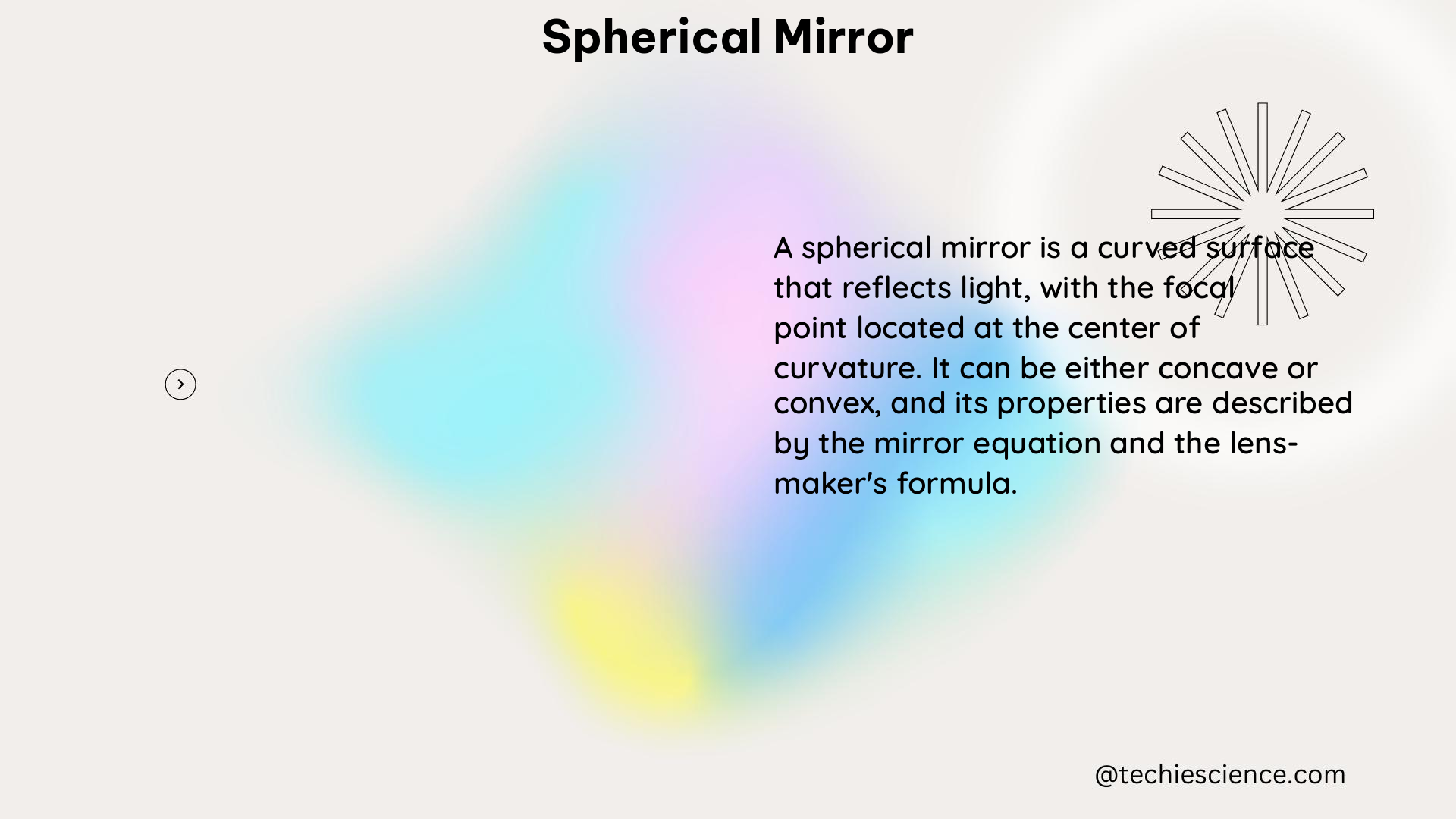Spherical mirrors are curved optical devices that have the shape of a portion of a sphere. These mirrors can be classified into two main types: concave mirrors, which curve inward, and convex mirrors, which curve outward. Understanding the behavior and properties of spherical mirrors is crucial in various fields, including optics, astronomy, and photography. This comprehensive guide will delve into the intricacies of spherical mirrors, providing you with a deep understanding of their fundamental principles, mathematical equations, and practical applications.
The Geometry of Spherical Mirrors
Spherical mirrors are characterized by their curvature, which is typically described by the radius of curvature (R). The relationship between the radius of curvature and the focal length (f) of a spherical mirror is given by the formula:
1/f = 2/R
For a concave mirror, the focal length is the distance from the mirror to the focal point, where parallel rays of light converge after reflection. Conversely, for a convex mirror, the focal length is the distance from the mirror to the virtual focal point, where parallel rays of light appear to diverge after reflection.
The Mirror Equation

The behavior of spherical mirrors is governed by the mirror equation, which relates the object distance (do), the image distance (di), and the focal length (f) of the mirror. The mirror equation is expressed as:
1/f = 1/do + 1/di
This equation is a fundamental tool for understanding the formation of images by spherical mirrors. It can be used to calculate the image distance and the magnification of an object placed in front of a spherical mirror.
Magnification and Image Formation
The magnification (M) of an object formed by a spherical mirror is given by the equation:
M = -di/do
The negative sign indicates that the image is inverted with respect to the object. The magnification can be used to determine the size and orientation of the image.
Depending on the position of the object relative to the mirror, spherical mirrors can form three types of images:
- Real and Inverted Image: Formed by a concave mirror when the object is placed beyond the center of curvature.
- Virtual and Upright Image: Formed by a concave mirror when the object is placed between the focal point and the mirror.
- Virtual and Upright Image: Formed by a convex mirror, regardless of the object’s position.
Numerical Examples
Let’s explore some numerical examples to better understand the application of the mirror equation and the calculation of image properties.
- Concave Mirror:
- Focal length (f) = 10 cm
- Object distance (do) = 20 cm
- Using the mirror equation: 1/f = 1/do + 1/di
- Solving for di, we get: di = 20 cm
-
Magnification (M) = -di/do = -20/20 = -1
-
Convex Mirror:
- Focal length (f) = -5 cm
- Object distance (do) = 15 cm
- Using the mirror equation: 1/f = 1/do + 1/di
- Solving for di, we get: di = -7.5 cm
-
Magnification (M) = -di/do = -(-7.5)/15 = 0.5
-
Concave Mirror with Radius of Curvature:
- Radius of curvature (R) = 20 cm
- Object distance (do) = 10 cm
- Using the formula: 1/f = 2/R
- Solving for f, we get: f = 10 cm
- Using the mirror equation: 1/do + 1/di = 1/f
- Solving for di, we get: di = 15 cm
- Magnification (M) = -di/do = -15/10 = -1.5
These examples demonstrate the application of the mirror equation and the calculation of image properties for both concave and convex spherical mirrors.
Practical Applications of Spherical Mirrors
Spherical mirrors have a wide range of applications in various fields:
- Telescopes and Astronomical Observations: Concave spherical mirrors are used as the primary mirrors in reflecting telescopes, such as the Newtonian telescope and the Cassegrain telescope.
- Microscopes and Magnifying Devices: Convex spherical mirrors are used as magnifying lenses in microscopes and other optical instruments.
- Automotive Mirrors: Convex spherical mirrors are commonly used as side-view mirrors in vehicles to provide a wider field of view.
- Security and Surveillance: Convex spherical mirrors are often used in security systems and surveillance applications to monitor a larger area.
- Lighting and Reflectors: Concave spherical mirrors are used in lighting fixtures, such as flashlights and car headlights, to focus the light beam.
DIY Spherical Mirror
If you’re interested in creating your own spherical mirror, you can follow these simple steps:
- Inflate a spherical balloon to the desired size.
- Cover a flat surface (e.g., a piece of cardboard) with aluminum foil, using spray adhesive to attach it securely.
- Spray the aluminum foil with silver spray paint, covering it evenly.
- Allow the paint to dry completely.
- Carefully deflate the balloon and remove it from the painted aluminum foil.
You now have a spherical mirror that can be used for various educational and experimental purposes. However, it’s important to note that this DIY spherical mirror is not suitable for applications that require precise optical properties.
Conclusion
Spherical mirrors are fascinating optical devices that play a crucial role in various scientific and technological applications. By understanding the fundamental principles, mathematical equations, and practical applications of spherical mirrors, you can unlock a deeper understanding of the world of optics and explore the fascinating realm of reflection and image formation.
References
- The Physics Classroom. (n.d.). The Mirror Equation. Retrieved from https://www.physicsclassroom.com/class/refln/Lesson-3/The-Mirror-Equation
- Texas Gateway. (n.d.). 8.6 Image Formation by Mirrors. Retrieved from https://www.texasgateway.org/resource/86-image-formation-mirrors
- The Physics Classroom. (n.d.). The Mirror Equation – Convex Mirrors. Retrieved from https://www.physicsclassroom.com/class/refln/Lesson-4/The-Mirror-Equation-Convex-Mirrors
- Optics4Kids. (n.d.). Spherical Mirrors. Retrieved from https://www.optics4kids.org/optics-encyclopedia/spherical-mirrors
- HyperPhysics. (n.d.). Spherical Mirrors. Retrieved from http://hyperphysics.phy-astr.gsu.edu/hbase/geoopt/sphmir.html

Hi, I am Sanchari Chakraborty. I have done Master’s in Electronics.
I always like to explore new inventions in the field of Electronics.
I am an eager learner, currently invested in the field of Applied Optics and Photonics. I am also an active member of SPIE (International society for optics and photonics) and OSI(Optical Society of India). My articles are aimed at bringing quality science research topics to light in a simple yet informative way. Science has been evolving since time immemorial. So, I try my bit to tap into the evolution and present it to the readers.
Let’s connect through